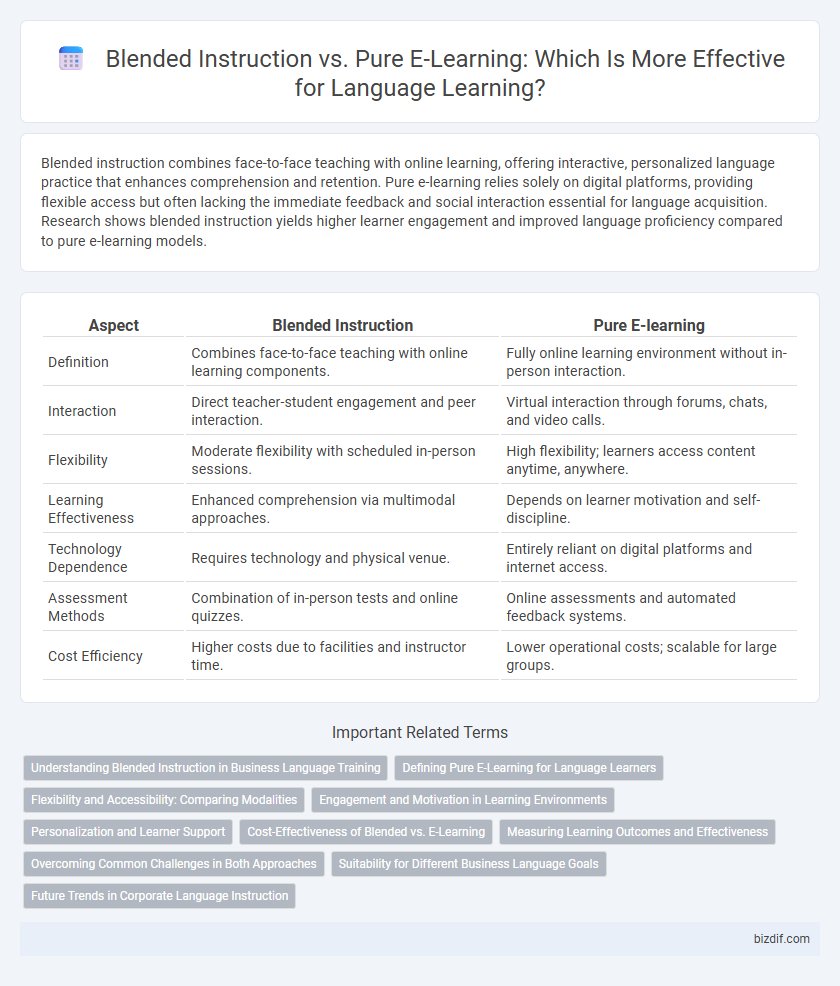Blended instruction combines face-to-face teaching with online learning, offering interactive, personalized language practice that enhances comprehension and retention. Pure e-learning relies solely on digital platforms, providing flexible access but often lacking the immediate feedback and social interaction essential for language acquisition. Research shows blended instruction yields higher learner engagement and improved language proficiency compared to pure e-learning models.
Table of Comparison
| Aspect | Blended Instruction | Pure E-learning |
|---|---|---|
| Definition | Combines face-to-face teaching with online learning components. | Fully online learning environment without in-person interaction. |
| Interaction | Direct teacher-student engagement and peer interaction. | Virtual interaction through forums, chats, and video calls. |
| Flexibility | Moderate flexibility with scheduled in-person sessions. | High flexibility; learners access content anytime, anywhere. |
| Learning Effectiveness | Enhanced comprehension via multimodal approaches. | Depends on learner motivation and self-discipline. |
| Technology Dependence | Requires technology and physical venue. | Entirely reliant on digital platforms and internet access. |
| Assessment Methods | Combination of in-person tests and online quizzes. | Online assessments and automated feedback systems. |
| Cost Efficiency | Higher costs due to facilities and instructor time. | Lower operational costs; scalable for large groups. |
Understanding Blended Instruction in Business Language Training
Blended instruction in business language training combines the interactive elements of face-to-face sessions with the flexibility of online learning, enhancing comprehension and retention. This approach integrates real-time feedback and practical communication drills with digital resources like video tutorials and language apps tailored to business contexts. Studies show that blended learning improves learner engagement and proficiency more effectively than pure e-learning by addressing diverse learning styles and providing contextualized practice.
Defining Pure E-Learning for Language Learners
Pure e-learning for language learners refers to fully online instruction where all course content, communication, and assessments occur through digital platforms without in-person interaction. This method leverages multimedia resources, interactive software, and virtual classrooms to immerse learners in language practice and comprehension. It offers flexibility and self-paced study but may lack the immediate feedback and social engagement found in blended instruction settings.
Flexibility and Accessibility: Comparing Modalities
Blended instruction offers enhanced flexibility by combining face-to-face interaction with online components, allowing learners to balance schedules while benefiting from direct teacher support. Pure e-learning maximizes accessibility by enabling learners to access materials anytime and anywhere, ideal for remote or diverse geographic locations. Both modalities accommodate different learning preferences, but blended instruction may present limitations in availability due to scheduled in-person sessions.
Engagement and Motivation in Learning Environments
Blended instruction combines face-to-face interaction with online learning, enhancing engagement by providing varied instructional methods and personalized feedback. Pure e-learning relies solely on digital platforms, which may pose challenges in maintaining learner motivation due to limited social interaction and immediate instructor support. Research shows that blended learning environments increase student motivation and engagement by integrating collaborative activities and real-time communication tools.
Personalization and Learner Support
Blended instruction combines face-to-face interaction with online resources, enabling personalized learning paths tailored to individual student needs, which pure e-learning platforms often struggle to fully replicate. Learner support is enhanced in blended models through direct access to instructors and peer collaboration, fostering immediate feedback and motivation. Pure e-learning relies heavily on automated tools and forums, which can limit personalized guidance and reduce learner engagement compared to the dynamic support found in blended environments.
Cost-Effectiveness of Blended vs. E-Learning
Blended instruction reduces costs by combining online digital media with traditional face-to-face teaching, lowering expenses linked to physical infrastructure and printed materials. Pure e-learning eliminates classroom-related costs entirely but may incur higher expenses in technology development, platform maintenance, and learner support services. Studies show blended instruction often achieves greater cost-effectiveness by balancing resource investment while enhancing learner engagement and retention.
Measuring Learning Outcomes and Effectiveness
Measuring learning outcomes in blended instruction offers richer data by combining online assessments with in-person evaluations, enhancing the accuracy of effectiveness analysis. Pure e-learning relies heavily on digital analytics and automated quizzes, which can sometimes limit insights into learner engagement and comprehension depth. Integrating qualitative feedback within blended models provides a more holistic understanding of instructional impact compared to the predominantly quantitative nature of pure e-learning metrics.
Overcoming Common Challenges in Both Approaches
Blended instruction overcomes common challenges by combining face-to-face interaction with digital resources, enhancing learner engagement and providing real-time feedback. Pure e-learning requires robust technology infrastructure and self-motivation strategies to address isolation and technical difficulties. Effective solutions include adaptive learning platforms, regular virtual check-ins, and interactive multimedia content to improve retention and learner satisfaction.
Suitability for Different Business Language Goals
Blended instruction offers a flexible approach combining face-to-face interaction with digital content, making it ideal for businesses aiming to improve practical communication skills and foster team collaboration. Pure e-learning provides scalable, cost-effective language training suited for companies targeting foundational knowledge or accommodating geographically dispersed teams. Choosing between blended and pure e-learning depends on the business's goals, whether prioritizing interactive skill development or efficient, widespread language accessibility.
Future Trends in Corporate Language Instruction
Corporate language instruction increasingly adopts blended instruction methods, combining in-person training with digital platforms to enhance learner engagement and retention. Future trends emphasize AI-driven personalized learning paths and real-time language proficiency analytics, surpassing the limitations of pure e-learning. Integration of immersive technologies like virtual reality is set to transform corporate language programs, fostering practical communication skills in global work environments.
Blended instruction vs Pure e-learning Infographic

 bizdif.com
bizdif.com